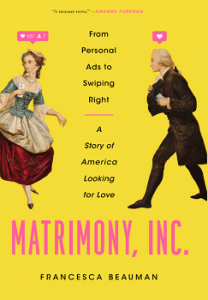On Writing MATRIMONY, INC.: From Personal Ads to Swiping Right, a Story of America Looking for Love
 I’ve always been interested in the history of the everyday. My first book was about the pineapple – yes, the pineapple! It may sound like a joke, but it was based upon my Cambridge University dissertation on the subject which revealed that the pineapple was one of the most potent status symbols of the eighteenth century, offered up at dinner parties by the likes of George Washington and Thomas Jefferson and cultivated in glasshouses in all the fanciest gardens across the East Coast. It is a way of understanding the history of the nation by examining it from an unusual angle – an approach I find revealing, refreshing and (most importantly if you’re the one researching and writing about it!) fun.
I’ve always been interested in the history of the everyday. My first book was about the pineapple – yes, the pineapple! It may sound like a joke, but it was based upon my Cambridge University dissertation on the subject which revealed that the pineapple was one of the most potent status symbols of the eighteenth century, offered up at dinner parties by the likes of George Washington and Thomas Jefferson and cultivated in glasshouses in all the fanciest gardens across the East Coast. It is a way of understanding the history of the nation by examining it from an unusual angle – an approach I find revealing, refreshing and (most importantly if you’re the one researching and writing about it!) fun.
So when I was thinking about writing another book, I kept my eyes open all around me. The history of parenting? (I’d just had my third baby.) The history of gossip columnists? (I was living in Los Angeles at the time.) The history of bureaucracy? (I did briefly pitch this idea to my agent, who responded in the kindest way she could, “That’s the most boring idea I’ve ever heard…”! I was surprised to find, however, that the answer was to be found late one night whilst giggling with a friend over her dating app profile.
Dating apps are, of course, more popular than ever. Heterosexual couples in the United States are now more likely to meet each other on the Internet than in any other way; a 2019 study by Stanford University found that 39 percent of heterosexual couples met through a dating website or app, versus 27 percent in a bar or restaurant, 20 percent through friends, and 11 percent at work.
This made me curious about the origins of all forms of advertising for love. When? Where? How? Why? What? As a historian by training, I have a keen awareness that very little in our world is truly new. Plus ca change, and all that. There was almost always an earlier iteration. And sure enough, it turned out there was, to a surprising and fascinating extent.
A little bit of initial research revealed that advertising for love in America dates back much, much further than most people realize. Relatively quickly, I was lucky enough to discover America’s first genuine marriage ad, which appeared in the Boston Evening Post in 1759. A gentleman advertised for “Any young lady, between the age of eighteen and twenty-three, of a middling stature, brown hair, of good Morals…” How revealing is this with regards to what a typical eighteenth century Bostonian wanted in a wife! That’s when I knew I was really on to something.
I then spent many, many months trawling through old newspapers and magazines, mostly at the UCLA library in Los Angeles and the British Library in London, as well as via a number of online databases which are wonderfully useful and unlock a number of new fields of research, including this one. This is my favourite aspect of my work: hours upon hours spent in the chilly, empty basement of a library, but oh! the triumph and glee you feel when you uncover a new primary source or make a revelatory discovery.
What I found in the course of examining large numbers of 18th– and 19th-century newspapers was the existence of personal ads in every state in the nation. From Wisconsin to Wyoming, from Kansas to California, the headline “Wife Wanted” and, later, “Husband Wanted” became a familiar sight. Taken together, they constitute an extraordinary body of evidence about the history of our hearts’ desires.
It was a constant battle during my research not to get distracted by a nearby article about a bizarre murder or a momentous event. I also started to obsess about what happened next to “my” advertisers. Which of these brave souls found themselves a husband or wife, a lover, a friend? Part of the fun of personal ads is they allow the reader to indulge in a little fantasy. Who was the advertiser? What did they look like? Each one is its own tiny detective story, asking the reader to unravel the intimate mysteries held within.
The central question I wanted to answer, though, was how the hundreds and hundreds of personal ads I uncovered, hardly any of which had seen the light of day since they first appeared in the newspaper, compared to the likes of Tinder, Hinge, or Match.com. Furthermore, what could they tell us about mate choice in America? What do women look for in a man? What do men look for in a woman? And how has this changed over the past two hundred and fifty years?
—
FRANCESCA BEAUMAN grew up in London, studied history at Cambridge, and began her career as the host and writer of numerous British TV shows, including ‘Show Me The Funny’ (Channel 4), ‘Heroes of History’ (Channel 5) and ‘Bring It On’ (BBC1). She is the author of six books: How to Wear White, Shapely Ankle Preferr’d, How to Crack an Egg With One Hand, The Woman’s Book and The Pineapple: King of Fruits. She remains the world’s leading expert on the history of the pineapple and the history of personal ads. In her spare time, Fran works at London’s most beautiful bookstore, Persephone Books. Her latest venture, the popular Instagram account about books, “Fran’s Book Shop,” is filmed on location there; Fran interviews authors, reviews books, and asks everyone from the window cleaner over the road to the movie star she meets at a party, “What Are You Reading?”
Fran’s Socials
https://www.francescabeauman.
https://www.instagram.com/
https://twitter.com/
MATRIMONY, INC.: From Personal Ads to Swiping Right, a Story of America Looking for Love (Pegasus Books; October 6, 2020; Hardcover; ISBN: 978-1643135786; 240 pgs; $27.95)
 A clever, thoughtful, and funny history that reveals how the Union of states was built on a much more personal union of people.
A clever, thoughtful, and funny history that reveals how the Union of states was built on a much more personal union of people.
What connects lonely homesteaders in 18th century New England to the millions of us today who use dating apps/websites to help find a partner? At once heartwarming and heartbreaking, Matrimony Inc. reveals the common thread that weaves its way through not just marriage and relationships over the centuries, but American social history itself: advertising for love.
Amazingly, America’s first personal ad appeared in the Boston Evening Post as early as 1759. A “person who flatters himself that he shall not be thought disagreeable” was in search of a “young lady, between the age of eighteen and twenty-three, of a middling stature, brown hair, of good Morals…” As family-arranged marriages fell out of fashion, “Husband Wanted” or “Seeking Wife” ads were soon to be found in every state in the nation.
From the woman in a Wisconsin newspaper who wanted “no brainless dandy or foppish fool” to the man with a glass eye who placed an ad in the New York Times hoping to meet a woman with a glass eye, the many hundreds of personal ads that author Francesca Beauman has uncovered offer an extraordinary glimpse into the history of our hearts’ desires, as well as a unique insight into American life as the frontier was settled and the cities grew. Personal ads played a surprisingly vital role in the West: couple by couple, shy smile by shy smile, letter by letter from a dusty, exhausted miner in California to a bored, frustrated seamstress in Ohio. Get ready for a new perspective on the making of modern America, a hundred words of typesetter’s blurry black ink at a time.
“So anxious are our settlers for wives that they never ask a single lady her age. All they require is teeth,” declared the Dubuque Iowa News in 1838 in a state where men outnumbered women three to one. While the dating pools of 21st century New York, Chicago or San Francisco might not be quite so dentally-fixated, Matrimony Inc. will put idly swiping right on Tinder into fascinating and vividly fresh historical context. What do women look for in a man? What do men look for in a woman? And how has this changed over the past 250 years?
Category: On Writing























